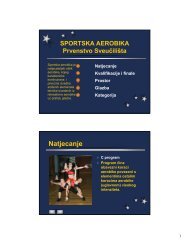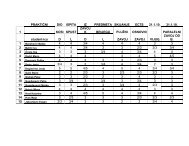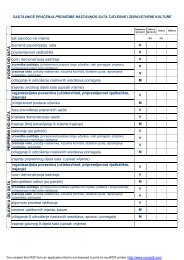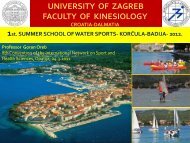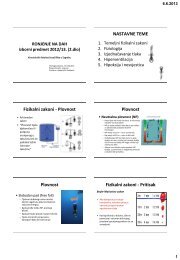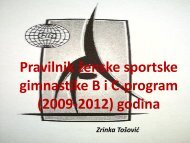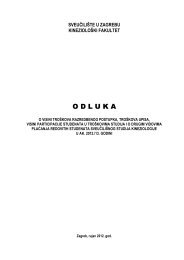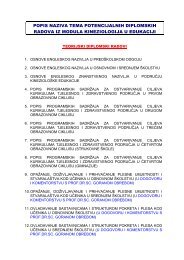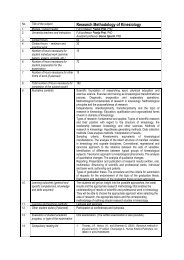The Journal of P hysiology Physiological adaptations to low-volume ...
The Journal of P hysiology Physiological adaptations to low-volume ...
The Journal of P hysiology Physiological adaptations to low-volume ...
Create successful ePaper yourself
Turn your PDF publications into a flip-book with our unique Google optimized e-Paper software.
1082 M. J. Gibala and others J Physiol 590.5<br />
regimensmayprovidecluesas<strong>to</strong>whyHITissucha<br />
potent intervention for promoting both health outcomes<br />
and enhancing athletic performance and exercise<br />
capacity.<br />
Conclusion and directions for future research<br />
Considerable evidence currently exists <strong>to</strong> support a role for<br />
<strong>low</strong>-<strong>volume</strong> HIT as a potent and time-efficient training<br />
method for inducing both central (cardiovascular) and<br />
peripheral (skeletal muscle) <strong>adaptations</strong> that are linked <strong>to</strong><br />
improved health outcomes. Limited work has examined<br />
the application <strong>of</strong> <strong>low</strong>-<strong>volume</strong> HIT in people with,<br />
or at risk for, cardiometabolic disorders, and at present<br />
the potential benefits <strong>of</strong> this type <strong>of</strong> training are<br />
unclear. Regardless <strong>of</strong> the group studied, the majority <strong>of</strong><br />
<strong>low</strong>-<strong>volume</strong> studies have utilized relatively short intervention<br />
periods (i.e. lasting up <strong>to</strong> several weeks). Future<br />
work involving long-term (i.e. months <strong>to</strong> years) interventions<br />
in a variety <strong>of</strong> clinical cohorts (i.e. individuals<br />
with insulin resistance, obesity, type 2 diabetes and cardiovascular<br />
disease) are urgently needed <strong>to</strong> better understand<br />
how manipulating the exercise stimulus impacts on<br />
cardiovascular and musculoskeletal remodelling in these<br />
populations. One aspect that is unclear from the present<br />
literature is the precise intensity and minimal <strong>volume</strong><br />
<strong>of</strong> training that is needed <strong>to</strong> potentiate the effect <strong>of</strong> the<br />
stimulus-adaptation on outcomes such as mi<strong>to</strong>chondrial<br />
biogenesis and relevant health markers. To answer such<br />
questions, a complex series <strong>of</strong> studies needs <strong>to</strong> be undertaken<br />
that systematically ‘titrate’ levels <strong>of</strong> the ‘training<br />
impulse’ and determine subsequent cellular, performance<br />
and clinical responses after divergent training interventions.<br />
In this regard, the perspectives gained from<br />
the use <strong>of</strong> supra-maximal interval-based training in<br />
well-trained athletes may aid in understanding why and<br />
how <strong>low</strong>-<strong>volume</strong> HIT improves health and functional<br />
performance in the general population and in many<br />
chronic disease states. Information derived from future<br />
studies will need <strong>to</strong> provide practical, evidence-based<br />
recommendations for novel exercise prescription that can<br />
be incorporated in<strong>to</strong> daily living and form an integral<br />
component in the development <strong>of</strong> future combina<strong>to</strong>rial<br />
therapies for the prevention and treatment <strong>of</strong> chronic<br />
inactivity-related diseases. If achieved, these goals will<br />
simultaneously reduce the economic burden associated<br />
with an inactive lifestyle.<br />
References<br />
Bartlett JD, Close GL, MacLaren DP, Gregson W, Drust B &<br />
Mor<strong>to</strong>n JP (2011). High-intensity interval running is<br />
perceived <strong>to</strong> be more enjoyable than moderate-intensity<br />
continuous exercise: implications for exercise adherence. J<br />
Sports Sci 29, 547–553.<br />
Ben<strong>to</strong>n CR, Nickerson JG, Lally J, Han XX, Hol<strong>low</strong>ay GP, Glatz<br />
JF, Luiken JJ, Graham TE, Heikkila JJ & Bonen A (2008).<br />
Modest PGC-1α overexpression in muscle in vivo is<br />
sufficient <strong>to</strong> increase insulin sensitivity and palmitate<br />
oxidation in subsarcolemmal, not intermy<strong>of</strong>ibrillar,<br />
mi<strong>to</strong>chondria. JBiolChem283, 4228–4240.<br />
Burgomaster KA, Howarth KR, Phillips SM, Rakobowchuk M,<br />
Macdonald MJ, McGee SL & Gibala MJ (2008). Similar<br />
metabolic <strong>adaptations</strong> during exercise after <strong>low</strong> <strong>volume</strong><br />
sprint interval and traditional endurance training in<br />
humans. JPhysiol586, 151–160.<br />
Burgomaster KA, Hughes SC, Heigenhauser GJ, Bradwell SN &<br />
Gibala MJ (2005). Six sessions <strong>of</strong> sprint interval training<br />
increases muscle oxidative potential and cycle endurance<br />
capacity in humans. JApplPhysiol98, 1985–<br />
1990.<br />
Chen Z-P, McConell GK, Michell BJ, Snow RJ, Canny BJ &<br />
Kemp BE (2000). AMPK signaling in contracting human<br />
skeletal muscle: acetyl-CoA carboxylase and NO synthase<br />
phosphorylation. Am J Physiol Endocrinol Metab 279,<br />
E1202–E1206.<br />
Clark SA, Chen ZP, Murphy KT, Aughey RJ, McKenna MJ,<br />
Kemp BE & Hawley JA (2004). Intensified exercise training<br />
does not alter AMPK signaling in human skeletal muscle. Am<br />
J Physiol Endocrinol Metab 286, E737–E743.<br />
Egan B, Carson BP, Garcia-Roves PM, Chibalin AV, Sarsfield<br />
FM, Barron N, McCaffrey N, Moyna NM, Zierath JR &<br />
O’Gorman DJ (2010). Exercise intensity-dependent<br />
regulation <strong>of</strong> PGC-1α mRNA abundance is associated with<br />
differential activation <strong>of</strong> upstream signalling kinases in<br />
human skeletal muscle. JPhysiol588, 1779–1790.<br />
Gibala MJ, Little JP, van Essen M, Wilkin GP, Burgomaster KA,<br />
Safdar A, Raha S & Tarnopolsky MA (2006). Short-term<br />
sprint interval versus traditional endurance training: similar<br />
initial <strong>adaptations</strong> in human skeletal muscle and exercise<br />
performance. JPhysiol575, 901–911.<br />
Gibala MJ & McGee SL (2008). Metabolic <strong>adaptations</strong> <strong>to</strong><br />
short-term high-intensity interval training: a little pain for a<br />
lot <strong>of</strong> gain? Exerc Sport Sci Rev 36, 58–63.<br />
Gibala MJ, McGee SL, Garnham AP, Howlett KF, Snow RJ &<br />
Hargreaves M (2009). Brief intense interval exercise activates<br />
AMPK and p38 MAPK signaling and increases the<br />
expression <strong>of</strong> PGC-1α in human skeletal muscle. JAppl<br />
Physiol 106, 929–934.<br />
Guellich A, Seiler S, Emrich E (2009). Training methods and<br />
intensity distribution <strong>of</strong> young world-class rowers. Int J<br />
Sports Physiol Perform 4, 448–460.<br />
Hawley JA, Myburgh KH, Noakes TD & Dennis SC (1997).<br />
Training techniques <strong>to</strong> improve fatigue resistance and<br />
enhance endurance performance. JSportsSci15,<br />
325–333.<br />
Hood MS, Little JP, Tarnopolsky MA, Myslik F & Gibala MJ<br />
(2011). Low-<strong>volume</strong> interval training improves muscle<br />
oxidative capacity in sedentary adults. Med Sci Sports Exerc<br />
43, 1849–1856.<br />
Hwang CL, Wu YT & Chou CH (2011). Effect <strong>of</strong> aerobic<br />
interval training on exercise capacity and metabolic risk<br />
fac<strong>to</strong>rs in people with cardiometabolic disorders: a<br />
meta-analysis. J Cardiopulm Rehabil Prev 31, 378–<br />
385.<br />
C○ 2012 <strong>The</strong> Authors. <strong>The</strong> <strong>Journal</strong> P<strong>hysiology</strong> C○ 2012 <strong>The</strong> <strong>Physiological</strong> Society<br />
Downloaded from J Physiol (jp.physoc.org) by guest on March 21, 2012




![NASTAVNI_PLAN_I_PROGRAM-_integrirani_studij [2,09 MiB]](https://img.yumpu.com/23830973/1/184x260/nastavni-plan-i-program-integrirani-studij-209-mib.jpg?quality=85)
